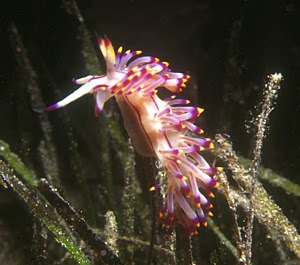"Look at me!"
A sea slug shows off its newly-acquired stingers using bright colors
Solar-powered sea slug (pnas.org)
Consider the plight of Cnidarians (sea anemones, coral, jelly fish), a phylum of aquatic invertebrates with a unique, ingenious weapon: stinging venomous cells. Cnidarians can release stinging harpoons that imbed themselves in an assailant (or prey) and release harmful chemicals that cause paralysis.
However, some Cnidarian predators have devised a clever method of retaliating against this defense mechanism. When these cells are ingested, animals like the sea slug (pictured above) recycle these stinging cells for their own use. They even use them against other Cnidarian prey.
Recently, scientists discovered that sea slugs are “stealing” other features too, with the discovery of the first photosynthetic animal. This clever sea slug (above) incorporates photosynthetic genes from algal prey into its own system, allowing it to produce chloroplasts and harness the light energy of the sun.
And we think organisms can't have it all... how can nature be so unfair?
Greenwood, P.G. Acquisition and use of nematocysts by cnidarian predators. (2009). Toxicon.
Rumpho, M.E. et al. Solar-Powered sea slugs. Mollusc/Algal chloroplast symbiosis. (2000). Plant Physiology.


